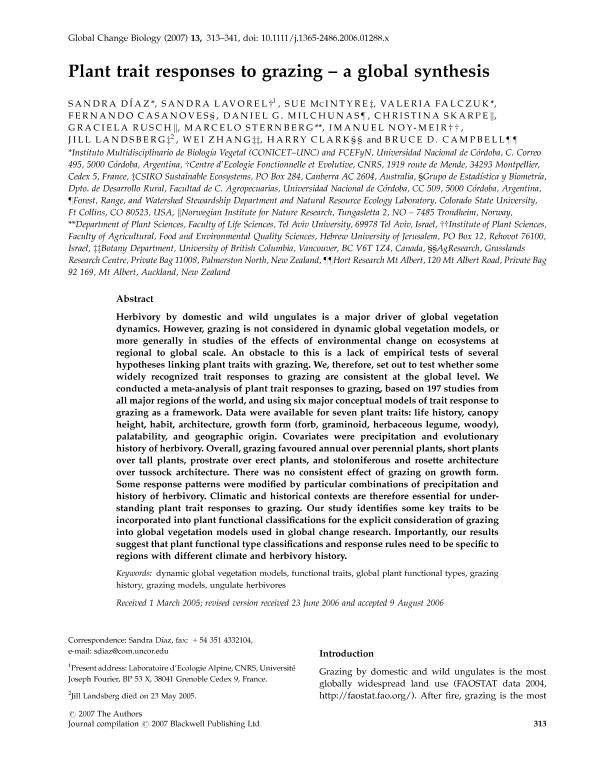Mostrar el registro sencillo del ítem
dc.contributor.author
Díaz, Sandra Myrna

dc.contributor.author
Lavorel, Sandra

dc.contributor.author
McIntayre, Sue
dc.contributor.author
Falczuk, Valeria

dc.contributor.author
Casanoves, Fernando

dc.contributor.author
Milchunas, Daniel G.
dc.contributor.author
Skarpe, Christina
dc.contributor.author
Rusch, Graciela
dc.contributor.author
Sternberg, Marcelo
dc.contributor.author
Noy-meir, Imanuel
dc.contributor.author
Landsberg, Jill
dc.contributor.author
Zhang, Wei
dc.contributor.author
Clark, Harry
dc.contributor.author
Campbell, Bruce D.
dc.date.available
2018-04-17T13:12:23Z
dc.date.issued
2007-02
dc.identifier.citation
Díaz, Sandra Myrna; Lavorel, Sandra; McIntayre, Sue; Falczuk, Valeria; Casanoves, Fernando; et al.; Plant responses to grazing: A global synthesis.; Wiley Blackwell Publishing, Inc; Global Change Biology; 13; 2; 2-2007; 313-341
dc.identifier.issn
1354-1013
dc.identifier.uri
http://hdl.handle.net/11336/42236
dc.description.abstract
Herbivory by domestic and wild ungulates is a major driver of global vegetation dynamics. However, grazing is not considered in dynamic global vegetation models, or more generally in studies of the effects of environmental change on ecosystems at regional to global scale. An obstacle to this is a lack of empirical tests of several hypotheses linking plant traits with grazing. We, therefore, set out to test whether some widely recognized trait responses to grazing are consistent at the global level. We conducted a meta-analysis of plant trait responses to grazing, based on 197 studies from all major regions of the world, and using six major conceptual models of trait response to grazing as a framework. Data were available for seven plant traits: life history, canopy height, habit, architecture, growth form (forb, graminoid, herbaceous legume, woody), palatability, and geographic origin. Covariates were precipitation and evolutionary history of herbivory. Overall, grazing favoured annual over perennial plants, short plants over tall plants, prostrate over erect plants, and stoloniferous and rosette architecture over tussock architecture. There was no consistent effect of grazing on growth form. Some response patterns were modified by particular combinations of precipitation and history of herbivory. Climatic and historical contexts are therefore essential for understanding plant trait responses to grazing. Our study identifies some key traits to be incorporated into plant functional classifications for the explicit consideration of grazing into global vegetation models used in global change research. Importantly, our results suggest that plant functional type classifications and response rules need to be specific to regions with different climate and herbivory history.
dc.format
application/pdf
dc.language.iso
eng
dc.publisher
Wiley Blackwell Publishing, Inc

dc.rights
info:eu-repo/semantics/openAccess
dc.rights.uri
https://creativecommons.org/licenses/by-nc-sa/2.5/ar/
dc.subject
Herbivory
dc.subject
Disturbance
dc.subject
Global Vegetation Dynamics
dc.subject.classification
Otras Ciencias Biológicas

dc.subject.classification
Ciencias Biológicas

dc.subject.classification
CIENCIAS NATURALES Y EXACTAS

dc.title
Plant responses to grazing: A global synthesis.
dc.type
info:eu-repo/semantics/article
dc.type
info:ar-repo/semantics/artículo
dc.type
info:eu-repo/semantics/publishedVersion
dc.date.updated
2018-04-03T19:23:20Z
dc.journal.volume
13
dc.journal.number
2
dc.journal.pagination
313-341
dc.journal.pais
Reino Unido

dc.journal.ciudad
Londres
dc.description.fil
Fil: Díaz, Sandra Myrna. Consejo Nacional de Investigaciones Científicas y Técnicas. Centro Científico Tecnológico Conicet - Córdoba. Instituto Multidisciplinario de Biología Vegetal. Universidad Nacional de Córdoba. Facultad de Ciencias Exactas Físicas y Naturales. Instituto Multidisciplinario de Biología Vegetal; Argentina
dc.description.fil
Fil: Lavorel, Sandra. Universite Joseph Fourier; Francia
dc.description.fil
Fil: McIntayre, Sue. CSIRO Sustainable Ecosystems; Nueva Zelanda
dc.description.fil
Fil: Falczuk, Valeria. Consejo Nacional de Investigaciones Científicas y Técnicas. Centro Científico Tecnológico Conicet - Córdoba. Instituto Multidisciplinario de Biología Vegetal. Universidad Nacional de Córdoba. Facultad de Ciencias Exactas Físicas y Naturales. Instituto Multidisciplinario de Biología Vegetal; Argentina
dc.description.fil
Fil: Casanoves, Fernando. Universidad Nacional de Córdoba. Facultad de Ciencias Agropecuarias; Argentina
dc.description.fil
Fil: Milchunas, Daniel G.. CSIRO Sustainable Ecosystems; Nueva Zelanda. State University of Colorado - Fort Collins; Estados Unidos
dc.description.fil
Fil: Skarpe, Christina. Norwegian Institute for Nature Research; Noruega
dc.description.fil
Fil: Rusch, Graciela. Norwegian Institute for Nature Research; Noruega
dc.description.fil
Fil: Sternberg, Marcelo. CSIRO Sustainable Ecosystems; Nueva Zelanda. Tel Aviv University; Israel
dc.description.fil
Fil: Noy-meir, Imanuel. The Hebrew University of Jerusalem; Israel
dc.description.fil
Fil: Landsberg, Jill. CSIRO Sustainable Ecosystems; Nueva Zelanda
dc.description.fil
Fil: Zhang, Wei. University of British Columbia; Canadá
dc.description.fil
Fil: Clark, Harry. Grasslands Research Centre; Nueva Zelanda
dc.description.fil
Fil: Campbell, Bruce D.. Hort Research Mt Albert; Nueva Zelanda
dc.journal.title
Global Change Biology

dc.relation.alternativeid
info:eu-repo/semantics/altIdentifier/url/https://onlinelibrary.wiley.com/doi/abs/10.1111/j.1365-2486.2006.01288.x
dc.relation.alternativeid
info:eu-repo/semantics/altIdentifier/doi/https://doi.org/10.1111/j.1365-2486.2006.01288.x
Archivos asociados
